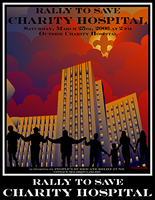|
The
Future of Charity Hospital
Charity Hospital
has risen, phoenix-like, from decimation in the past. It has
been destroyed by hurricanes and fire. Charity may yet rise
again. And yet perhaps Katrina’s catastrophic flooding
was simply the final, tragic step in Charity’s slow
decline. Much has changed in the healthcare environment since
Jean Louis founded the hospital for the city’s poor.
What ultimately happens to Charity Hospital is predicated
on three questions: What is the best way to provide health
care to those who are too poor to afford health insurance?
How best to educate future physicians? And what is the best
way to model the city’s hospital capacity based on actual
need? The answers to these questions have only begun to be
addressed by federal, state and local officials.
 The
debate over whether to reopen Charity is less about Charity
and more about how the poor and uninsured should receive medical
care in the city. There are two currents of thought on this
matter. The first feels that there will always be a large
poor population in New Orleans and therefore a large uninsured
population. For this reason, a safety net must exist to care
for those persons when ill. This view holds that a large,
public financed hospital is the best way to ensure this. The
other view feels that rather than concentrating federal and
state money into a separate charity budget that funds an ageing
and inconvenient hospital, that money is better spent in some
way following the patient. That is, if money is tied to a
particular patient, a patient can obtain care wherever he
or she chooses. With the closing of Charity, many uninsured
patients are now seeking care at private hospitals such as
Ochsner and Tulane. These hospitals feel strongly the state
or federal government needs to reimburse them for uninsured
care. The
debate over whether to reopen Charity is less about Charity
and more about how the poor and uninsured should receive medical
care in the city. There are two currents of thought on this
matter. The first feels that there will always be a large
poor population in New Orleans and therefore a large uninsured
population. For this reason, a safety net must exist to care
for those persons when ill. This view holds that a large,
public financed hospital is the best way to ensure this. The
other view feels that rather than concentrating federal and
state money into a separate charity budget that funds an ageing
and inconvenient hospital, that money is better spent in some
way following the patient. That is, if money is tied to a
particular patient, a patient can obtain care wherever he
or she chooses. With the closing of Charity, many uninsured
patients are now seeking care at private hospitals such as
Ochsner and Tulane. These hospitals feel strongly the state
or federal government needs to reimburse them for uninsured
care.
Federal officials
have indicated Louisiana’s archaic two-tiered system
(that is, one tier for those with insurance, and one for those
without) must be changed. Much of the current debate is over
how to shape that new system.
At the same time,
LSU officials feel their educational mission has been severely
compromised with the loss of Charity, and that a new hospital
must be built with state funds. Perhaps this hospital would
address many of the problems the old Charity had: inadequate
facilities, lack of proper infection control, a dwindling
emphasis on research. In this way a new LSU hospital, perhaps
part of a joint venture with the VA, could be a boon to the
city in terms of innovative patient care and new opportunities
for research. At the same time, two potential problems exist.
The first is whether New Orleans’ smaller population
warrants another large hospital, or if current facilities
can be better utilized to meet healthcare needs. The second
is how this hospital fits into a state financed charity system,
if that system continues to exist. In contrast, Tulane’s
educational mission was much better positioned after the storm,
due to its private hospital and affiliation with Ochsner and
other city institutions.
Tulane’s
rich and storied history with Charity continues. The mission
of service to the poor and needy continues unabated within
the student body and faculty of Tulane. How that mission becomes
reality, whether through a new Charity hospital or through
new and existing relationships with other healthcare facilities
in the area, remains to be seen. Tulane and Charity have endured
many upheavals throughout their history, and current times
are no exception.
Adapted from
the following sources:
Salvaggio J. New Orleans' Charity Hospital: A story of physicians,
politics, and power. Baton Rouge: Louisiana State University
Press; 1993.
Kostmayer HW. The Tulane School of Medicine: 1834 - 1960.
The Bulletin of the Tulane University Medical Faculty. 1961;
20(4):219-239.
A Short History of the Ambulance Corps. Jambalaya, the Tulane
University Yearbook, 1905.
Ochsner J. The complex life of Rudolph Matas. J Vasc Surg 2001;34:387-92.
prev | 1
| 2 | 3
| 4 | 5
| 6 | 7
| 8 | 9 |



